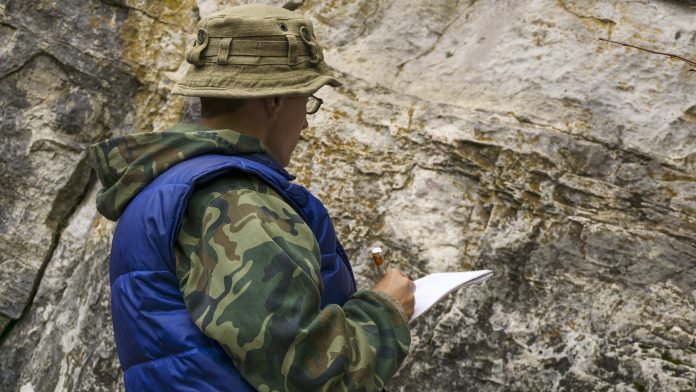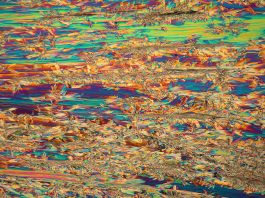The Norra Kärr region in Sweden is home to mainland Europe’s largest defined heavy rare earth mineral deposit. As the race to secure rare earth elements increases, Axel Sjöqvist of the University of Gothenburg outlines its significance.
The transition to sustainable energy systems is taking place. The number of electric vehicles on our roads is growing exponentially. Solar and wind power plants are being built on an unprecedented scale. While these technologies are crucial to fulfilling our collective sustainability goals, they require more minerals and metals in their construction than the fossil-fuel-burning equivalents they replace. We are transitioning from a fossil-fuel dependency to a mineral dependency.
Rare earth elements (REEs) are essential ingredients in various technologies, including displays, catalytic converters, low-energy lighting, batteries, lasers, and powerful magnets. In fact, rare-earth magnets are the strongest permanent magnets available. As a result, they are used in applications ranging from magnet toys to MRI scanners. Rare earth magnets are vital components in wind turbines and most electric vehicles, and therefore their demand is projected to increase steadily and rapidly. Wind turbines can generate more power, and electric vehicles drive longer distances thanks to rare earth magnets.
The REEs are a group of 17 chemical elements (see Fig. 1). They include scandium, yttrium, and the 15 lanthanoid elements. Many REEs were first discovered in Sweden in minerals from two Swedish sites. The heavy REEs were discovered in 1794 as a mixture of oxides, named ‘yttria’, in the mineral gadolinite from the Ytterby feldspar mine in the Stockholm Archipelago. The light REEs were discovered in 1804 also as a mixture of oxides, named ‘ceria’, in the mineral cerite from Bastnäs in the Bergslagen mining region. Due to their similar chemical properties, it took more than a century of research, including discoveries of many false new elements, before the REEs were finally untangled.
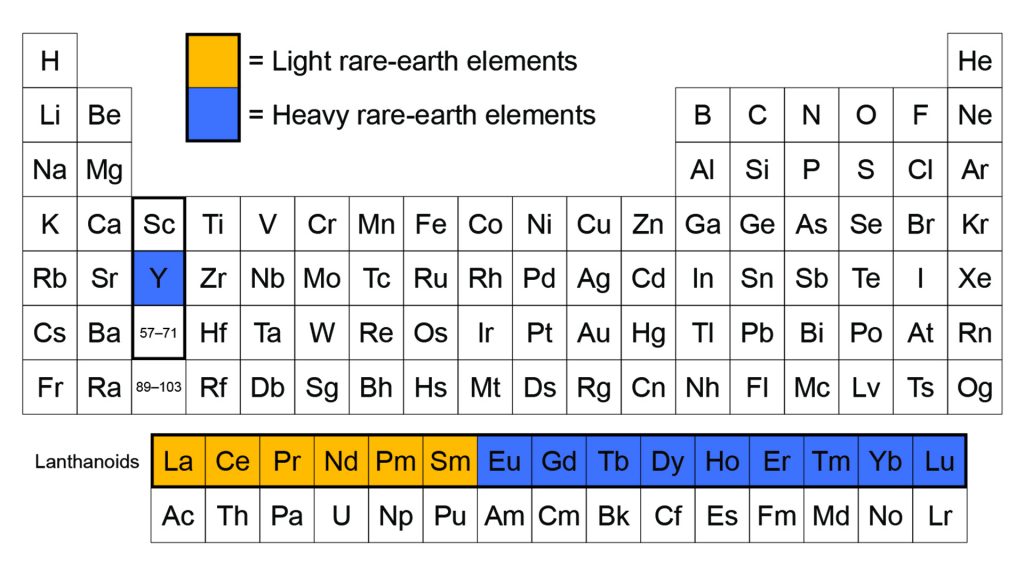
There is currently no production of REEs in the European Union, which relies on importing 98–99% from China. Production of REEs from Chinese sources has been associated with environmental and health problems. Furthermore, China has administered tight export restrictions on these elements. As a result, REEs are the raw materials with the highest risk of a supply shortage in the European Union. It is more urgent than ever to find alternatives for a reliable domestic supply, both from recycling and mining.
Rare earth elements in Sweden: Norra Kärr
The alkaline rocks at Norra Kärr, located in Southern Sweden, and recently the topic of my PhD thesis in Geology (Ample Rare Elements: A Geochemical Anomaly in the Earth’s Crust at Norra Kärr), contain mainland Europe’s largest defined heavy rare earth mineral deposit: 110 million tonnes of rock containing on average 0.5% total rare earth oxide of which 52% heavy rare earth oxide (Inferred Mineral Resource, NI 43-101 compliant). Potential by-products are zirconium, niobium, and a feldspar–nepheline powder. The REEs are mainly found in the rock variety grennaite, named after the local town Gränna.
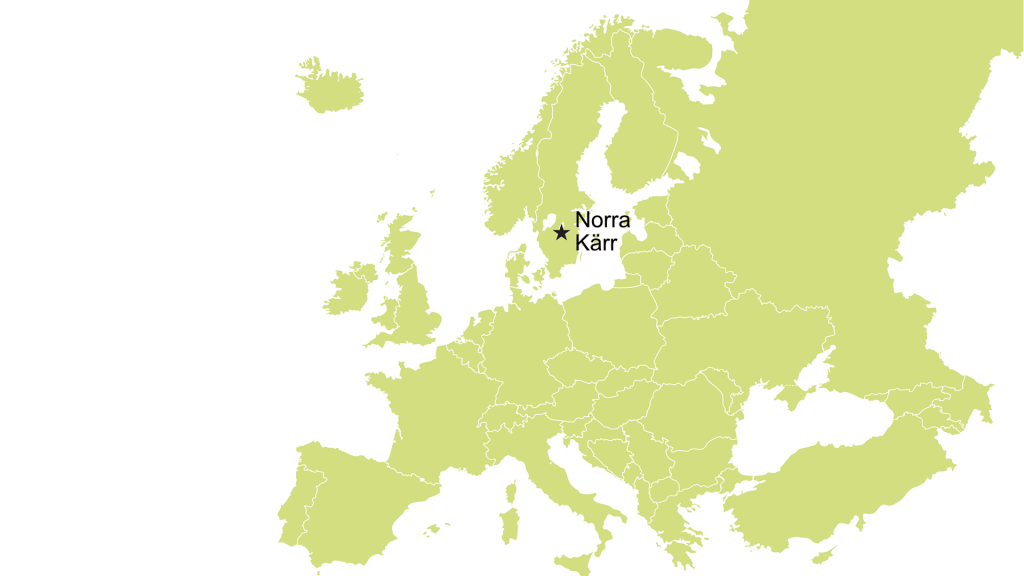
The mineral deposit formed from a batch of magma (molten rock) with a highly evolved composition approximately 1.5 billion years ago. The grennaite magma became enriched in REEs through a process called fractional crystallisation. This involved the slow crystallisation of a much larger volume of parental magma at great depth, where REEs were concentrated in the gradually decreasing volume of remaining magma. The remaining magma eventually rose through the Earth’s crust and solidified to form the grennaite at a shallow depth.
Grennaite is a fine-grained green rock classified as aegirine nepheline syenite in petrographic terms. It is characterised by high sodium and potassium concentrations relative to aluminium and a critically undersaturated silica content. In addition, grennaite holds abundant REEs, zirconium, niobium, and volatile elements fluorine and chlorine. This chemical state has led to the formation of exotic minerals such as eudialyte (chemical formula: Na15Ca6Fe3Zr3Si(Si25O73)(O,OH,H2O)3(Cl,OH)2), which is the primary host for REEs in Norra Kärr.
Subsequently, the grennaite was affected by mountain-building processes approximately one billion years ago, which occurred when Rodinia, the supercontinent before Pangea, was assembled. During this time, mountains as high as the Himalayas were present along the Swedish West Coast. The grennaite was scrunched up by tectonic forces and heated to the point where the rocks partially remelt. Rare earth elements were redistributed by the remelting process and deposited in coarse-grained veins (see Fig. 2).
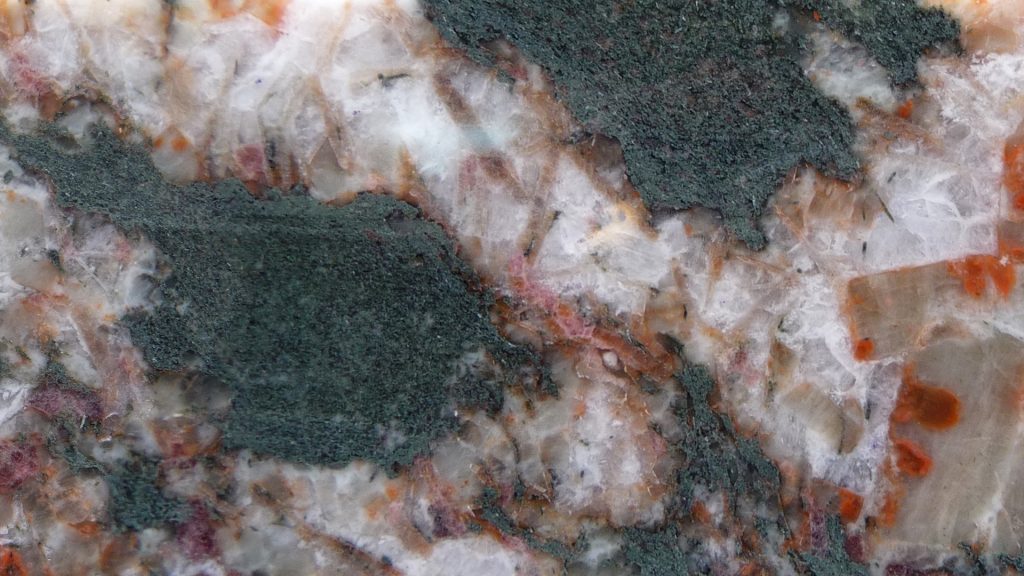
The role of geological research
Why is geological research important? Don’t we know everything we need to know about these rocks by now? Even though the bottleneck for securing a sustainable supply of REEs in the European Union is not a geological understanding of the mineral resources, geologists have a role.
Firstly, eudialyte-bearing alkaline igneous rocks, including the rocks investigated in Norra Kärr, have become one of the prime targets of rare earth mineral exploration, globally speaking. While eudialyte seems to be a promising source of REEs, there has never taken place any commercial mining or REE production from this mineral. Therefore, investigations into its mode of occurrence, chemical composition, and physical characteristics are of global importance. Ultimately, a better understanding of the mineral eudialyte will lead to more resource-efficient exploitation.
Secondly, rocks tend to occur together in clans, associated in space and time. They are shaped by a common process, share a source of heat and fluids or a common tectonic framework. Therefore, an understanding of the formation processes of one deposit may guide the search for more deposits of the same type. While the age of the REE deposit at Norra Kärr is known with a high degree of confidence, similar rocks have not yet been identified.
Thirdly, geologists play a role in communicating the state of raw material supply security to a broader audience of laypeople and decision-makers. We geologists know where metals come from and in which minerals they are found. Geologists have a bottom-up perspective on how dirt from the ground contributes to a sustainable supply of raw materials for society. We should stand with one boot firmly on the ground and with the other in the public debate.
The social license at Norra Kärr
The company operating the Norra Kärr project was granted a mining lease by the Swedish Mining Inspectorate in May 2013. A Swedish mining lease gives rights to the land for a duration of 25 years. This decision was appealed to the government, which in January 2014 decided not to revoke the mining lease. After another appeal, the Supreme Administrative Court of Sweden revoked the mining lease in February 2016. The company then had to complete their original application for a mining lease to the Mining Inspectorate. The Mining Inspectorate decided in May 2021 to not award a mining lease to the company. The company has appealed the Mining Inspectorate’s decision to the government. In addition to a mining lease, Swedish mining projects also need to secure an environmental permit.
The Norra Kärr project is located 1.5km from the shore of Sweden’s second-largest lake, Vättern, which is a source of drinking water for 250,000 people. Citizens, organisations, and politicians have expressed concerns that mining in their backyard could adversely affect the local environment and, ultimately, the water quality in the lake. Although a survey in 2014 showed that fewer than half of the locals were directly opposed to the project, there is a significant amount of resistance and protest by a concerned local community. This is a community that feels heavy pressure coming from the European Union, which believes a mine at Norra Kärr would be an essential contribution to securing a primary supply of REEs.
The road to a domestic supply of REEs is long, and it has been a bumpy ride so far. I cannot help but conclude: we are not there yet.
Please note, this article will also appear in the ninth edition of our quarterly publication.
References
1 Bowell, R.J., Chapman, C., McDougall, C., Martindale, R., Pittuck, M., 2021. Preliminary Economic Assessment of Norra Kärr Rare Earth Deposit and Potential By-Products, Sweden.
2 European Commission, 2020. Critical Raw Materials Resilience: Charting a Path towards greater Security and Sustainability. Report COM(2020) 474 final.
3 Gadolin, J., 1794. Undersökning af en svart tung Stenart ifrån Ytterby Stenbrott i Roslagen. Kongliga Vetenskapsacademiens Nya Handlingar 15, 137–155.
4 Gauß, R., Burkhardt, C., Carencotte, F., Gasparon, M., Gutfleisch, O., Higgins, I., Karajić, M., Klossek, A., Mäkinen, M., Schäfer, B., Schindler, R., Veluri, B., 2021. Rare Earth Magnets and Motors: A European Call for Action. A report by the Rare Earth Magnets and Motors Cluster of the European Raw Materials Alliance.
5 Hisinger, W., Berzelius, J., 1804. Cerium, ein neues Metall aus einer Schwedischen Steinart, Bastnäs Tungstein genannt. Neues allgemeines Journal der Chemie 2, 397–418.
6 Sjöqvist, A.S.L., 2021. Ample Rare Elements: A Geochemical Anomaly in the Earth’s Crust at Norra Kärr. PhD thesis, University of Gothenburg.
Axel Sjöqvist
Geologist, PhD
Department of Earth Sciences
University of Gothenburg
www.gu.se/en/earth-sciences
https://twitter.com/AxelSjoqvist
https://www.linkedin.com/school/university-of-gothenburg/

